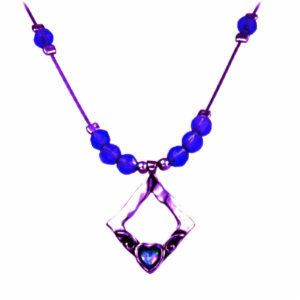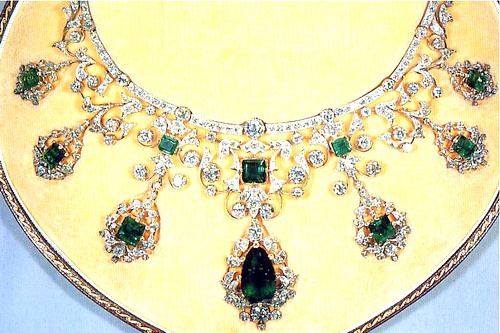



The Godman Emerald and Diamond Necklace
©Her Majesty Queen Elizabeth II
The characteristic feature of this intricately designed emerald is its perfect symmetry, which can be checked easily, by picking out any point on the necklace on one side of the median line and looking for its corresponding point on the other side. It is seen easily that whatever point is picked on one side of the necklace, there undoubtedly will be a corresponding point on the other side.
History of the Godman Necklace
The origin of the necklace
The Godman Necklace was purchased by the British naturalist Frederick Du Cann while on holiday in Bavaria, in the 1890s. It is not known from where and from whom the purchase of the necklace was made. The two Godman sisters claimed that the necklace originated from Empress Josephine of France, the wife and Empress consort of Napoleon Bonaparte. Perhaps this was what their father Frederick Du Cann told them. The period from around 1860 to around 1830, is known as the neo-classical era in jewelry crafting, and the jewelry produced during this period have typical shapes and ornamentation inspired by classical themes of ancient Greece and Rome. In France this period corresponds to one of the most tumultuous periods in its history, that included the French revolution and the conquests of Napoleon Bonaparte. The Godman Necklace doesn't seem to have many characteristics of the neo-Classical era and therefore doubts have been cast about its provenance from the period of Napoleon Bonaparte.
The use of floral and vegetable motifs for jewelry designing became very popular during the Baroque period, that began in the early 17th century, and persisted into the neo-classical and modern periods. However, in the neo-classical period the floral and vegetable motifs were combined with classical themes of ancient Greece and Rome such as palmettes, rosettes, vases, urns, ribbon bows, hearts, stars, the crescent moon etc. There was a high level of symmetry in the neo-classical designs. The floral motifs and the high level of symmetry in the design are two features that point to its possible neo-classical origins. In the 1890s, when the necklace was purchased, Bavaria was still a kingdom ruled by the House of Wittelsbach. In fact, the Kingdom of Bavaria was ruled by the kings of the House of Wittelsbach for over 700 years, from 1180 until its fall in 1918. The royal court of Munich the center of the monarchy in Bavaria, rivaled the courts of Paris, London and Madrid in their extravagance and display of jewelry at court ceremonies. Thus it is quite possible that the Godman Necklace perhaps belonged to one of the monarchs of the House of Wittelsbach, and was designed and crafted by the artisans and craftsmen based in Munich, which like Paris and London was a center of jewelry designing and manufacture during this period.
The Godman Sisters present the necklace to Her Majesty Queen Elizabeth II
Frederick Du Cann gave the emerald and diamond necklace to his two daughters in 1965. Several years after the death of Frederick Du Cann his daughters wrote to the Lord Chamberlain, as the chief functionary of the royal court, that they believed they owned a piece of jewelry that once belonged to Empress Josephine of France, the Empress Consort and first wife of Napoleon Bonaparte. They further wrote that having a royal provenance the piece of jewelry might be of interest to Her Majesty Queen Elizabeth II, and that if it would please Her Majesty, they would be most willing to gift it to Her Royal Highness.
The elderly spinsters received a response from the Lord Chamberlain, requesting them to meet Sir Francis Watson, the surveyor for the Queen's works of art, at an appointed time in their Bank, where the necklace was stored in a vault. The trio met at the bank as planned and the necklace was retrieved from the vault and handed over to Sir Francis, by the two sisters. The necklace was taken to the Buckingham Palace and shown to Her Majesty the Queen, who with her experience in handling and wearing exquisitely crafted jewelry from her own collection, was apparently very much pleased with the necklace she had just seen. The necklace was sent to the court jewelers and other experts of antique jewelry to verify its provenance, and doubts were expressed about its Napoleonic origin. The two sisters were informed of the findings, and the doubts cast on its royal provenance. Nevertheless the two sisters replied that they would like to present the necklace to the Queen if Her Majesty would be pleased to accept it, and also would like the Queen to wear it occasionally. The Queen was delighted to add the necklace to her collection, and to thank the sisters for their kind gesture, the Queen invited the two sisters to the Buckingham Palace for a private audience.
Differentiation of crown jewels from personal jewels
The first British Monarch to differentiate the royal jewels into two categories the crown jewels and personal jewels, was Queen Victoria. The concept had already been introduced by Peter the Great in Russia in 1719, when he set up the Russian Crown Treasury to house a collection of jewels, which belonged not to the Romanov family, but to the Russian State. Peter the Great placed all state regalia in this collection, and declared that the state holdings were inviolate and could not be altered sold or given away, and he also declared that each subsequent emperor or empress should leave a certain number of pieces acquired during their reign to the State, for the permanent glory of the Russian Empire.
Queen Victoria made it clear that some pieces belonged to the crown and were for use by any Queen to follow her, and that some pieces were her personal property, and hers to dispose of as she saw it fit. All British Monarchs after Queen Victoria had followed her in her footsteps, and had recognized the two categories of jewelry ever since. Thus the present royal jewels of the British royal family are also divided into the Crown Jewels and the personal jewelry collection of the Queen. The British Crown Jewels are on display in the Jewel House of the Tower of London, while the personal jewelry collection of the Queen is kept in a vault in the Buckingham Palace.











.jpg)
